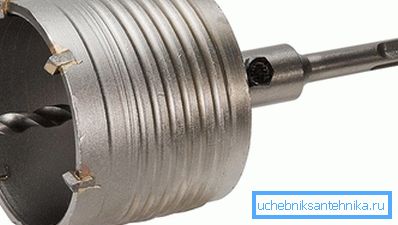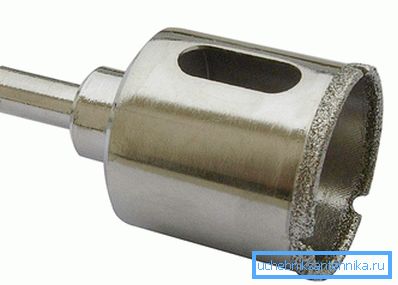How to make holes under the pipe
It is known that when laying water and sewer pipes, it is necessary to route them through various obstacles, such as walls, floors and other elements of building structures.
But before you make holes under the pipe, it is advisable to familiarize yourself with the known methods of implementing such operations, which often affect not only the supporting structures of the structure, but also their finishing. In specific conditions of laying the pipeline can be used a variety of techniques that are supposed to be considered in our article.
What you need to know?

Arrangement of openings in the supporting walls and partitions implies the observance of the well-known requirements laid down in the existing building regulations. When preparing them, it is necessary to carefully monitor that such crucial elements of building structures and communications as are not damaged:
- reinforcing and barrier grids;
- electrical wiring lines;
- elements of the ventilation system (if available).
In addition, a hole prepared in a wall or floor should provide the possibility of placing a special protective sleeve in it, which, if necessary, can be insulated with any non-combustible material (mineral wool, for example).
General procedure

Before you cut a hole in the wall - it is recommended to examine its surface with the help of a simple metal detector for the presence of electrical wiring or reinforcement rods in this place.
As for the main working tool, for the purposes indicated by us, a perforator is usually used, or a sufficiently powerful hammer drill with a crown-type attachment, with which you can make holes of various diameters. The order of their preparation in this case is as follows:
- first, in the right place of the wall, a circle is marked, the diameter of which is equal to the section of the pipe (together with the sleeve);
- then using a crown of the appropriate size to drill a hole in the wall;
- when “slipping” the nozzle, a piercer and a hammer will be required, using which it will be possible to destroy the material in a non-drilling area;
- after that, it will be possible to continue work until the finished hole is obtained.

To cut complex holes in various materials, it will be necessary to prepare a set of crowns of various sizes. For drilling partitions of drywall, foam concrete, as well as wooden walls, you can use conventional steel drills.

Tip! In the case when it is necessary to drill a hole in the concrete, a set of special drill bits will be required. With their help, you can work with materials 10-15 cm thick.
Work with complex coatings

Tip! The main problem when working with tiled surfaces (in bathrooms, bathrooms and in the kitchen) is the fragility of the cladding material, for the preservation of which it is recommended to drill not in percussion mode.
In preparing the holes of large diameter, you can use the following techniques:
- use as a nozzle a special diamond "crown", when using which the drill should operate in the low speed mode;
- use a special device called a ballerina;
- in order to eliminate the possibility of the teeth of the nozzle or the tip of the ballerina with the surface of the tile smooth and covered with a layer of hard glaze, the latter is scratched with a file or sealed with a piece of masking tape.

For making holes in the tile is often used more simple and cheap, but more risky way, which consists in the following. First, using a standard drill with a diameter of 3-4 mm, several holes are drilled inside the marked circle. Then the gaps between these holes are carefully destroyed and removed with a well-sharpened chisel. And at the end of the work, by means of the same chisel, the edges of the hole expand to the specified size.
Preparation of holes in the floor

The order of preparation of the indicated holes depends both on the type of the sex base itself, and on the type of decorative coating that is laid on top of it.
Before starting work, first of all it is necessary to decide on whether it can be removed by cutting or disassembling a piece of decorative coating in places where pipes are laid. If it is impossible to perform these operations, a hole in the finishing material (in a tile, for example), as well as in the most sexual basis is made by the methods already described earlier.
Video
Cut a large hole under the chimney immediately difficult. The author of the video shows how to do this by drilling small holes in a circle. Further it will help to cut a hole of the desired diameter with a crown: